

Antithesis Worksheets

Giving Explanations
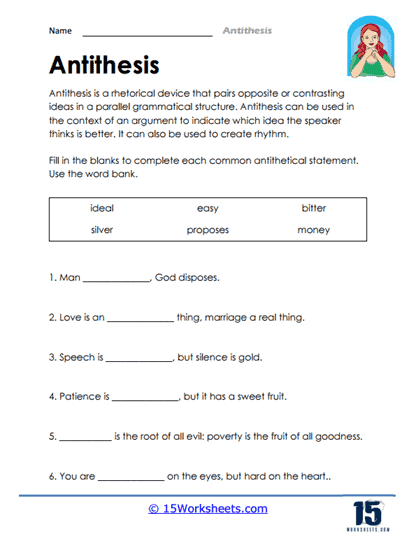
Fill In The Blanks
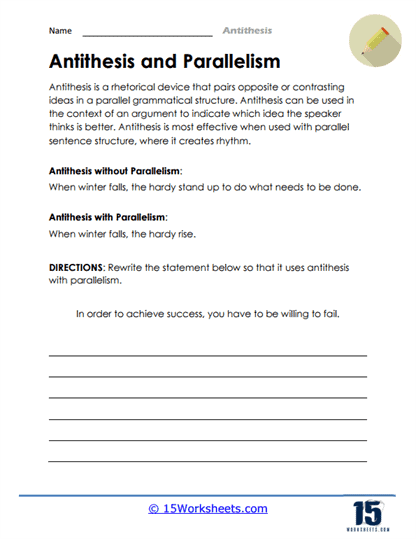
Understanding Parallelism
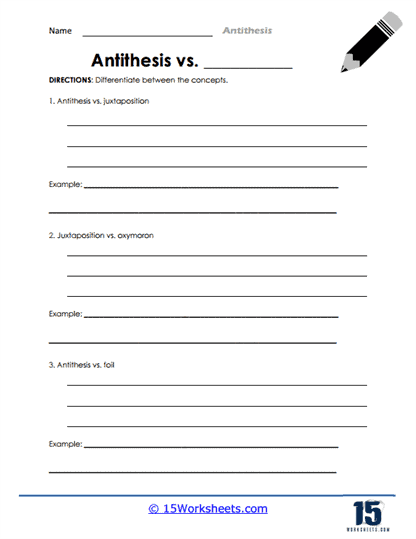
Compare And Contrast
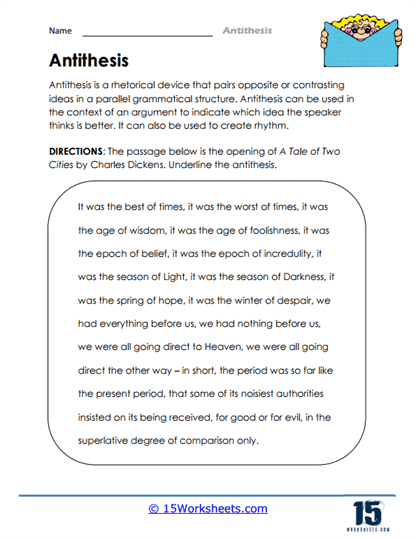
A Tale Of Two Cities
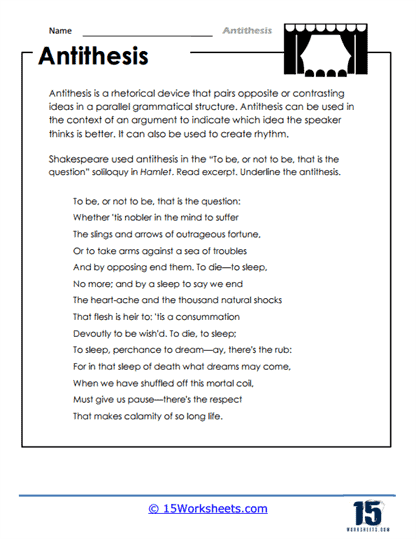
To Be Or Not To Be
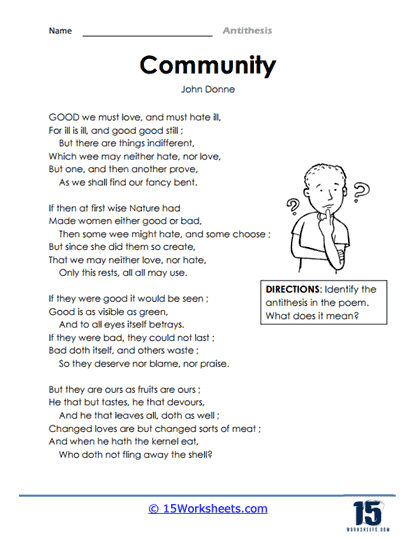
Poetry Analysis
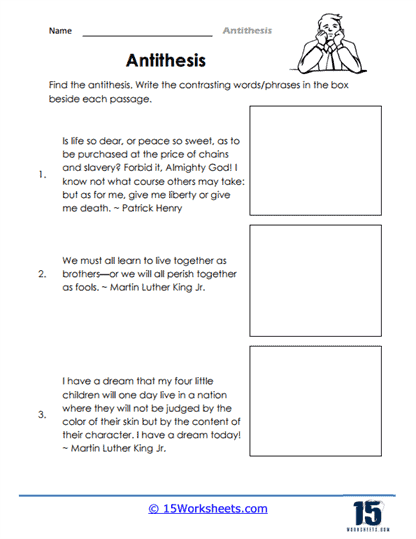
Contrasting Words
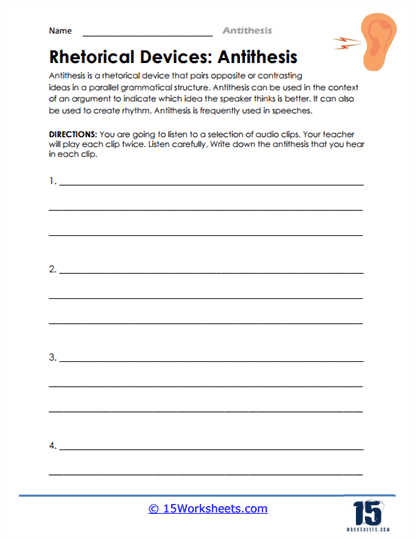
Listening Challenge
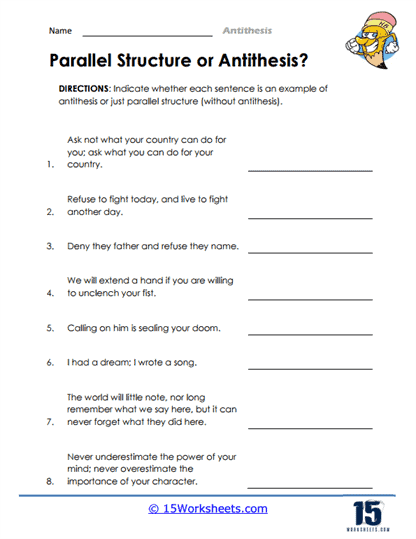
Stylistic Devices Mastery

Quoted Statements
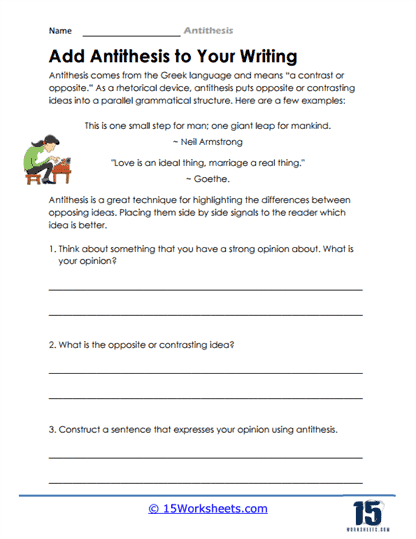
Express Your Opinion
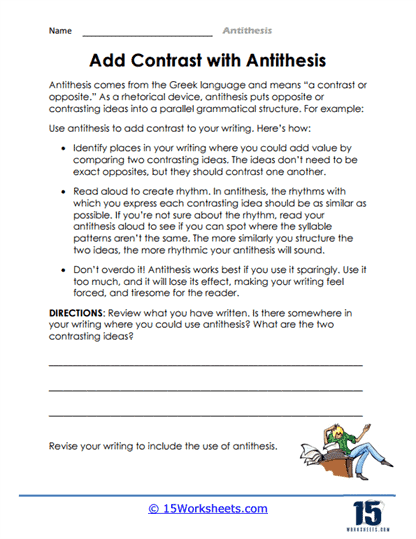
Writing And Revising
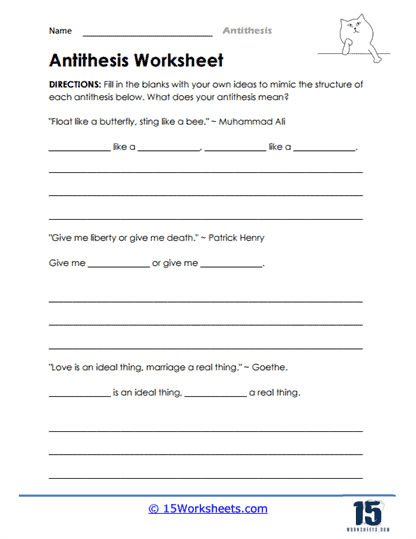
Copying The Formula
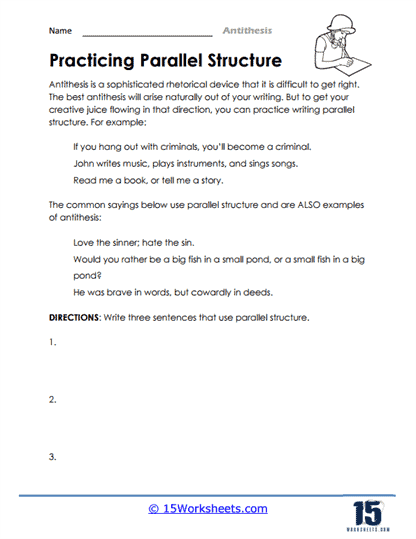
Parallel Practice
All about these 15 worksheets.
Antithesis, the rhetorical device that juxtaposes contrasting ideas or words within a sentence to create a balanced and thought-provoking effect, is a powerful tool in writing and communication. Understanding and mastering antithesis not only enhances a student’s grasp of persuasive techniques but also sharpens critical thinking, strengthens argumentative skills, and fosters a deeper appreciation for language and rhetoric.
In a world where effective communication and critical analysis are paramount, students must develop the ability to recognize and employ antithesis in their writing and speech. To empower students with the art of antithesis and its myriad applications, we proudly present a collection of 15 worksheets on Antithesis. These worksheets are meticulously designed to provide students with structured and engaging opportunities to explore, practice, and master the art of antithesis.
What Is Antithesis?
So, imagine you’re playing a game where one superhero is super strong, like the Hulk, and another is incredibly fast, like the Flash. They’re very different from each other, right? They have opposite powers. Now, this concept of opposites is what we call “antithesis” in literature.
Antithesis is a fancy word that we use when two contrasting or opposite ideas are put together in a sentence to create a dramatic, powerful, or thought-provoking effect. You know, like “It was the best of times, it was the worst of times,” from a famous book called “A Tale of Two Cities.” It means the time was so crazy it felt like the best and worst at once. See how the contrast creates an interesting idea?
Imagine these worksheets like a playbook for a new game you want to master, or a guide to draw your favorite superhero step-by-step. These worksheets are like a training arena to help you understand, identify, and even create your own antithesis examples.
These worksheet consist of several different sections. The first section might have sentences with antithesis already in them, asking you to spot and underline the contrasting ideas. It’s like a game of ‘I spy,’ but with words.
The second section could give you half of a sentence, asking you to complete it with a contrasting idea. For instance, if you get “As slow as a ____,” you could write, “As slow as a snail, but as fast as a cheetah.” You created an antithesis!
The third section might challenge you to come up with your own sentences using antithesis, starting from scratch. It’s like making up your own super-powered characters and their stories.
And the best part is, as you practice with these worksheets, you’ll become a master of creating striking contrasts. This is super useful in school, especially when writing essays or stories. It’s like adding a superpower to your writing, making it more engaging and dramatic!
To sum it up, antithesis worksheets are like your gym for writing muscles, helping you become a stronger, more creative writer. So the next time you write a story or an essay, you’ll be like a superhero, using the power of antithesis to make your writing more exciting and compelling!
Why Do Authors Use This Technique?
Authors use the literary device of antithesis in their work for a variety of reasons. Here are a few:
Creates Contrast – One of the primary reasons is to create a strong contrast between two ideas or characters. This can highlight a conflict or a dilemma, making it more vivid and engaging for the reader. For example, “To err is human, to forgive divine,” highlights the contrast between human frailty and divine perfection.
Enhances Meaning – By placing two opposing ideas next to each other, an antithesis can help clarify or deepen the meaning of each. It’s like looking at a photograph where the background helps you better understand the foreground.
Adds Dramatic Effect – Antithesis can add a sense of drama or tension to a piece of writing. It makes the text more memorable and impactful, capturing the reader’s attention.
Emphasizes a Point – Authors often use antithesis to emphasize a particular point or theme. By presenting two contrasting ideas, the author draws the reader’s attention to the differences and helps them see a concept in a new light.
Provides Balance – In poetry and prose, antithesis can provide a balance or rhythm to the language. This can make a piece of writing more aesthetically pleasing and easier to read, and can also help emphasize the themes the author is exploring.
Provokes Thought – Lastly, antithesis can provoke thought by presenting contradictory or opposing ideas. This can challenge readers, encouraging them to engage more deeply with the text and to think critically about the issues it raises.
The Importance of Understanding Antithesis
Understanding antithesis and its various forms is of great importance for several reasons:
- Persuasive Communication: Antithesis is a persuasive technique used to emphasize contrasting ideas, making it a valuable tool for effective communication and argumentation.
- Critical Thinking: Recognizing antithesis in speeches, literature, and persuasive writing prompts students to think critically about the structure and impact of language in various contexts.
- Enhanced Writing Skills: Learning to use antithesis in their own writing allows students to create compelling arguments, essays, and speeches.
- Literary Appreciation: Antithesis is a common device in literature, and understanding it enables students to appreciate the artistry and rhetorical devices used by authors.
This collection of Antithesis worksheets is a valuable resource for educators and parents committed to nurturing effective communication, critical thinking, and persuasive writing skills in students. Proficiency in recognizing, analyzing, and employing antithesis equips individuals with the tools to engage their audience, convey ideas persuasively, and appreciate the artistry of language and rhetoric.
This collection is an investment in their future success, ensuring they have the language skills to communicate with impact, conviction, and persuasive power. Explore these Antithesis worksheets today, and watch your students become masterful communicators who can skillfully balance contrasting ideas for maximum rhetorical effect.
- Skip to primary navigation
- Skip to main content
- Skip to primary sidebar
- Skip to footer
KidsKonnect
Reading Comprehension Cause and Effect Context Clues Compare and Contrast
Noun Worksheets Writing Prompts Compound Words Figurative Language
The Wizard of Oz Hans Christian Andersen Types of Writing Text Structure
Literary Devices
Alliteration Hyperbole Metaphor Irony
Subject Verb Agreement Poetry Climax Rhyme
View all reading worksheets
Action Verbs Tragedy Transition Words Phonics
View all writing worksheets
Dramatic Irony Cacophony Anaphora Setting
View all literature worksheets
Abbreviations Transition Words Conclusion Situational Irony
View all literary device worksheets
Women’s History
Inspirational Women Women's History Month First Lady of the US Women's Equality Day International Women's Day
View all Women's History worksheets
American Revolution
American Revolution Patriots & Loyalists Patrick Henry Sons of Liberty
View all American Revolution worksheets
US Constitution US Independence Trail of Tears The Pilgrims
View all US History worksheets
Ancient History
Ancient China Ancient Mayan Ancient Rome Ancient Aztec
View all Ancient History worksheets
World History
Roaring Twenties Industrial Revolution Middle Ages The Renaissance
View all World History worksheets
Famous Wars
World War 1 World War 2 Vietnam War American Civil War
View all Famous War worksheets
Anne Frank Sally Ride Neil Armstrong Christopher Columbus
View all famous figure worksheets
Joe Biden Donald Trump Abraham Lincoln George Washington
View all President worksheets
Roald Dahl Dr Seuss JK Rowling Michael Morpurgo
View all author worksheets
Civil Rights
Rosa Parks Sojourner Truth Medger Evers Martin Luther King
Elvis Presley Johann Sebastian Bach Ella Fitzgerald Wolfgang Mozart
View all musician worksheets
Thomas Edison Albert Einstein Henry Ford Wright Brothers
View all inventor worksheets
Muhammad Ali Michael Jordan Jackie Robinson Jesse Owens
View all athlete worksheets
Nat Turner Ruby Bridges Harriet Tubman Booker T Washington Malcolm X
View all civil rights worksheets
Natural Wonders
River Nile Mount Everest Sahara Desert Mount Etna Ancient Pyramids Amazon River
Landmarks/Sights
Mount Rushmore Statue Of Liberty White House Stonehenge Great Wall of China Santa Fe Trail
New York Texas South Carolina Alaska Nevada Ohio
Australia United Kingdom China Canada Argentina Brazil
Mount Fuji Mississippi River Rocky Mountains Volcano Glacier The Great Barrier Reef
View all natural wonders worksheets
Hoover Dam Bermuda Triangle Leaning Tower Of Pisa Arc De Triomphe Golden Gate Bridge Colosseum
View all landmark worksheets
California Colorado Indiana Florida Washington Georgia
View all US state worksheets
Poland Greece Philippines Japan France India
View all country worksheets
March Topics
Women’s History Month International Women’s Day Purim Easter Holi Ramadan St. Patrick’s Day Spring Vernal Equinox Ostara
View all Seasonal worksheets
Social Emotional Learning
Morals and Values Self Management Ethics Depression Relationship Skills Self-Awareneess Self-Esteem Emotions and Feelings Goal-Setting Interpersonal Skills
View all Social-Emotional Learning worksheets
Celebrations
Easter Saint Patrick’s Day Valentines Day Chinese New Year Rosh Hashanah Thanksgiving Flag Day Cinco de Mayo Beginning Of Lent Yom Kippur View all Celebrations worksheets
Remembrance
Pearl Harbor Day Veterans’ Day Memorial Day Battle Of The Somme D-Day 9/11 Anzac Day Martin Luther King Jr. Day International Women’s Day Victoria Day View all Remembrance worksheets
Camels Fox Bears Penguin Wolf Beavers Mountain Lion Red Panda Snow Leopard White Tigers Silverback Gorilla Okapi
View all mammal worksheets
Marine Life
Crabs Starfish Fish Octopus Great White Shark Dolphin Walrus Narwhal Megalodon Shark Killer Whale Beluga Whale Lionfish
View all marine life worksheets
Insects/Invertebrates/Reptiles
Millipede Praying Mantis Ladybug Ants Spider Iguana Chameleon Komodo Dragon Lizard Bearded Dragon Gila Monster Snakes
View all insect worksheets
Eagle Peregrine Falcon Snowy Owl Emu Woodpecker Albatross Swan Quail Bald Eagle Hummingbird Peacock
View all Bird worksheets
Natural World
Avalanche Flood Tsunami Natural Disasters Fossils Ice Age
View all natural world worksheets
Earth Sciences
Water Cycle Global Warming Deciduous Forests Hurricane Sandy Hurricane Katrina Global Warming
View all earth science worksheets
Food Chain Fossils Photosynthesis Cells Ecosystem Plants
View all biology worksheets
Solar System Black Holes Eclipse Stars and Constellations The Moon Comets
View all space worksheets
Chemistry/Physics
Magnetism Graduated Cylinders Solid, Liquid, Gas Gravity Light Sound
View all science worksheets
Kangaroo Horse Bear Lion Lizard Octopus
View all animal worksheets
Addition Sentences Single Digital Addition Two-Digit Addition Three Digit Addition Repeated Addition
View all Addition Worksheets
Ordinal Numbers Cardinal Numbers Rounding Numbers Odd & Even Numbers Comparing Numbers
View all Numbers Worksheets
Counting Money Subtracting Money Change Money Coin Name & Value Calculate Change (Money)
View all Money Worksheets
Number Line Single Digit Subtraction Place Value Subtraction Sentences Input & Output Tables
View all Math Worksheets
Antithesis Examples and Worksheets
Search for worksheets, download the antithesis examples and worksheets.
Click the button below to get instant access to these worksheets for use in the classroom or at a home.
Download This Worksheet
This download is exclusively for KidsKonnect Premium members! To download this worksheet, click the button below to signup (it only takes a minute) and you'll be brought right back to this page to start the download! Sign Me Up
Edit This Worksheet
Editing resources is available exclusively for KidsKonnect Premium members. To edit this worksheet, click the button below to signup (it only takes a minute) and you'll be brought right back to this page to start editing! Sign Up
This worksheet can be edited by Premium members using the free Google Slides online software. Click the Edit button above to get started.
Download This Sample
This sample is exclusively for KidsKonnect members! To download this worksheet, click the button below to signup for free (it only takes a minute) and you'll be brought right back to this page to start the download! Sign Me Up
Table of Contents
Definition of Antithesis
Antithesis is a literary device designed to highlight the difference/s of two irreconcilable opposites. Structurally, the contrasting ideas (be it concepts, words, phrases or sentences) are placed in sharp juxtaposition and sustained tension, i.e. observing correct grammar and parallelism, in order to achieve the ultimate contrasting effect. The well-balanced or parallel structure makes the comparison easier and highlights the contradictions between the ideas.
Antitheses are common in both writing and speeches. Here are a few examples:
- This famous expression by Muhammad Ali displays two contrasting animal actions: a silent (floating) butterfly and an aggressive (sting) bee.
- It presents the contrasting qualities of speech versus silence and silver versus gold .
- It highlights the differences between rude and kind and between sadness and joy .
Here’s an antithesis-laden excerpt from Pres. Abraham Lincoln’s speech:
When there is need of silence , you speak , and when there is need of speech , you are dumb . When you are present , you wish to be absent , and when absent , you desire to be present . In peace you are for war , and in war you long for peace . In council you descant on bravery , and in the battle you tremble .
In sum, an antithesis is composed of three main components: (1) at least two parts, (2) contrasting ideas, and (3) a parallel grammatical structure.
Antithesis vs. irony vs. juxtaposition
Oftentimes, antithesis is mistaken as irony when used in speech. Although both are used to convey contrasts of ideas, they have a distinction: antithesis is structured with parallelism in mind, whereas irony implies contradictions between appearance and reality through tone or choice of words. See examples below:
- Antithesis: Temperance leads to happiness; intemperance ends, in general, to misery.
- Irony: You found yourself in a no-smoking zone on your cigarette break.
Juxtaposition, on the other hand, is used to also highlight the differences between two things, but those two things do not necessarily have to be totally opposites. This rhetorical device compares similar things so that the audience will spot the subtle differences. Juxtaposition also does not require sentence parallelism or balanced grammatical structure. One popular example of this literary device is the expression “When it rains, it pours,” which means when one thing goes right, many things will go right; also, when one thing goes wrong, everything goes wrong.
Functions and Antithesis Examples
Literally meaning “opposite,” antithesis is commonly used among writers as it adds color and flavor to their works. This literary tool can be used to show the character’s mindset and personality as well as set up an argument. Here are some of literary works where the use antithesis stands out:
- It was the best of times, it was the worst of times. (Tale of Two Cities by Charles Dickens)
- Better to reign in Hell, than serve in Heav’n. in Paradise Lost by John Milton
- To err is human; to forgive divine. – An Essay on Criticism by Alexander Pope
- Give every man thy ear, but few thy voice. – Hamlet by William Shakespeare
Antithesis is also commonly used among famous personalities’ speeches and in common quotes and idioms. Here are a few examples:
- We must learn to live together as brothers or perish together as fools. ( Martin Luther King, Jr .)
- And so, my fellow Americans: ask not what your country can do for you — ask what you can do for your country. My fellow citizens of the world: ask not what America will do for you, but what together we can do for the freedom of man. (John F. Kennedy Jr.)
- We will extend a hand if you are willing to unclench your fist. ( Barack Obama )
- That’s one small step for man, one giant leap for mankind. ( Neil Armstrong )
- I would rather be ashes than dust! I would rather that my spark should burn out in a brilliant blaze than it should be stifled by dryrot. I would rather be a superb meteor, every atom of me in magnificent glow, than a sleepy and permanent planet. The proper function of man is to live, not to exist. I shall not waste my days in trying to prolong them. I shall use my time. (Jack London)
- Love is an ideal thing, marriage a real thing. (Goethe)
- Patience is bitter, but it has a sweet fruit. (Aristotle)
- Integrity without knowledge is weak and useless, and knowledge without integrity is dangerous and dreadful. (Samuel Johnson)
- Folks who have no vices have very few virtues. (Abraham Lincoln)
- All the joy the world contains has come through wishing happiness for others. All the misery the world contains has come through wanting pleasure for oneself. (Shantideva)
Antithesis Worksheets
This bundle contains 5 ready-to-use antithesis worksheets that are perfect to test student knowledge and understanding of what antithesis is and how it can be used. You can use these antithesis worksheets in the classroom with students, or with home schooled children as well.
Link/cite this page
If you reference any of the content on this page on your own website, please use the code below to cite this page as the original source.
Link will appear as Antithesis Examples and Worksheets: https://kidskonnect.com - KidsKonnect, August 8, 2017
Use With Any Curriculum
These worksheets have been specifically designed for use with any international curriculum. You can use these worksheets as-is, or edit them using Google Slides to make them more specific to your own student ability levels and curriculum standards.
Related Resources
KidsKonnect is a growing library of high-quality, printable worksheets for teachers and homeschoolers.
Home Facts Privacy About Blog Contact Terms
Safe & Secure
We pride ourselves on being a safe website for both teachers and students. KidsKonnect uses a secure SSL connection to encrypt your data and we only work with trusted payment processors Stripe and PayPal.

Antithesis Definition
What is antithesis? Here’s a quick and simple definition:
Antithesis is a figure of speech that juxtaposes two contrasting or opposing ideas, usually within parallel grammatical structures. For instance, Neil Armstrong used antithesis when he stepped onto the surface of the moon in 1969 and said, "That's one small step for a man, one giant leap for mankind." This is an example of antithesis because the two halves of the sentence mirror each other in grammatical structure, while together the two halves emphasize the incredible contrast between the individual experience of taking an ordinary step, and the extraordinary progress that Armstrong's step symbolized for the human race.
Some additional key details about antithesis:
- Antithesis works best when it is used in conjunction with parallelism (successive phrases that use the same grammatical structure), since the repetition of structure makes the contrast of the content of the phrases as clear as possible.
- The word "antithesis" has another meaning, which is to describe something as being the opposite of another thing. For example, "love is the antithesis of selfishness." This guide focuses only on antithesis as a literary device.
- The word antithesis has its origins in the Greek word antithenai , meaning "to oppose." The plural of antithesis is antitheses.
How to Pronounce Antithesis
Here's how to pronounce antithesis: an- tith -uh-sis
Antithesis and Parallelism
Often, but not always, antithesis works in tandem with parallelism . In parallelism, two components of a sentence (or pair of sentences) mirror one another by repeating grammatical elements. The following is a good example of both antithesis and parallelism:
To err is human , to forgive divine .
The two clauses of the sentence are parallel because each starts off with an infinitive verb and ends with an adjective ("human" and "divine"). The mirroring of these elements then works to emphasize the contrast in their content, particularly in the very strong opposite contrast between "human" and "divine."
Antithesis Without Parallelism
In most cases, antitheses involve parallel elements of the sentence—whether a pair of nouns, verbs, adjectives, or other grammar elements. However, it is also possible to have antithesis without such clear cut parallelism. In the Temptations Song "My Girl," the singer uses antithesis when he says:
"When it's cold outside , I've got the month of May ."
Here the sentence is clearly cut into two clauses on either side of the comma, and the contrasting elements are clear enough. However, strictly speaking there isn't true parallelism here because "cold outside" and "month of May" are different types of grammatical structures (an adjective phrase and a noun phrase, respectively).
Antithesis vs. Related Terms
Three literary terms that are often mistakenly used in the place of antithesis are juxtaposition , oxymoron , and foil . Each of these three terms does have to do with establishing a relationship of difference between two ideas or characters in a text, but beyond that there are significant differences between them.
Antithesis vs. Juxtaposition
In juxtaposition , two things or ideas are placed next to one another to draw attention to their differences or similarities. In juxtaposition, the pairing of two ideas is therefore not necessarily done to create a relationship of opposition or contradiction between them, as is the case with antithesis. So, while antithesis could be a type of juxtaposition, juxtaposition is not always antithesis.
Antithesis vs. Oxymoron
In an oxymoron , two seemingly contradictory words are placed together because their unlikely combination reveals a deeper truth. Some examples of oxymorons include:
- Sweet sorrow
- Cruel kindness
- Living dead
The focus of antithesis is opposites rather than contradictions . While the words involved in oxymorons seem like they don't belong together (until you give them deeper thought), the words or ideas of antithesis do feel like they belong together even as they contrast as opposites. Further, antitheses seldom function by placing the two words or ideas right next to one another, so antitheses are usually made up of more than two words (as in, "I'd rather be among the living than among the dead").
Antithesis vs. Foil
Some Internet sources use "antithesis" to describe an author's decision to create two characters in a story that are direct opposites of one another—for instance, the protagonist and antagonist . But the correct term for this kind of opposition is a foil : a person or thing in a work of literature that contrasts with another thing in order to call attention to its qualities. While the sentence "the hare was fast, and the tortoise was slow" is an example of antithesis, if we step back and look at the story as a whole, the better term to describe the relationship between the characters of the tortoise and the hare is "foil," as in, "The character of the hare is a foil of the tortoise."
Antithesis Examples
Antithesis in literature.
Below are examples of antithesis from some of English literature's most acclaimed writers — and a comic book!
Antithesis in Charles Dickens' A Tale of Two Cities
In the famous opening lines of A Tale of Two Cities , Dickens sets out a flowing list of antitheses punctuated by the repetition of the word "it was" at the beginning of each clause (which is itself an example of the figure of speech anaphora ). By building up this list of contrasts, Dickens sets the scene of the French Revolution that will serve as the setting of his tale by emphasizing the division and confusion of the era. The overwhelming accumulation of antitheses is also purposefully overdone; Dickens is using hyperbole to make fun of the "noisiest authorities" of the day and their exaggerated claims. The passage contains many examples of antithesis, each consisting of one pair of contrasting ideas that we've highlighted to make the structure clearer.
It was the best of times , it was the worst of times , it was the age of wisdom , it was the age of foolishness , it was the epoch of belief , it was the epoch of incredulity , it was the season of Light , it was the season of Darkness , it was the spring of hope , it was the winter of despair , we had everything before us, we had nothing before us, we were all going direct to Heaven , we were all going direct the other way —in short, the period was so far like the present period, that some of its noisiest authorities insisted on its being received, for good or for evil, in the superlative degree of comparison only.
Antithesis in John Milton's Paradise Lost
In this verse from Paradise Lost , Milton's anti-hero , Satan, claims he's happier as the king of Hell than he could ever have been as a servant in Heaven. He justifies his rebellion against God with this pithy phrase, and the antithesis drives home the double contrast between Hell and Heaven, and between ruling and serving.
Better to reign in Hell than serve in Heaven.
Antithesis in William Shakespeare's Othello
As the plot of Othello nears its climax , the antagonist of the play, Iago, pauses for a moment to acknowledge the significance of what is about to happen. Iago uses antithesis to contrast the two opposite potential outcomes of his villainous plot: either events will transpire in Iago's favor and he will come out on top, or his treachery will be discovered, ruining him.
This is the night That either makes me or fordoes me quite .
In this passage, the simple word "either" functions as a cue for the reader to expect some form of parallelism, because the "either" signals that a contrast between two things is coming.
Antithesis in William Shakespeare's Hamlet
Shakespeare's plays are full of antithesis, and so is Hamlet's most well-known "To be or not to be" soliloquy . This excerpt of the soliloquy is a good example of an antithesis that is not limited to a single word or short phrase. The first instance of antithesis here, where Hamlet announces the guiding question (" to be or not to be ") is followed by an elaboration of each idea ("to be" and "not to be") into metaphors that then form their own antithesis. Both instances of antithesis hinge on an " or " that divides the two contrasting options.
To be or not to be , that is the question: Whether 'tis nobler in the mind to suffer The slings and arrows of outrageous fortune Or to take arms against a sea of troubles, And by opposing end them ...
Antithesis in T.S. Eliot's "Four Quartets"
In this excerpt from his poem "Four Quartets," T.S. Eliot uses antithesis to describe the cycle of life, which is continuously passing from beginning to end, from rise to fall, and from old to new.
In my beginning is my end . In succession Houses rise and fall , crumble, are extended, Are removed, destroyed, restored, or in their place Is an open field, or a factory, or a by-pass. Old stone to new building , old timber to new fires ...
Antithesis in Green Lantern's Oath
Comic book writers know the power of antithesis too! In this catchy oath, Green Lantern uses antithesis to emphasize that his mission to defeat evil will endure no matter the conditions.
In brightest day , in blackest night , No evil shall escape my sight. Let those who worship evil's might Beware my power—Green lantern's light!
While most instances of antithesis are built around an "or" that signals the contrast between the two parts of the sentence, the Green Lantern oath works a bit differently. It's built around an implied "and" (to be technical, that first line of the oath is an asyndeton that replaces the "and" with a comma), because members of the Green Lantern corps are expressing their willingness to fight evil in all places, even very opposite environments.
Antithesis in Speeches
Many well-known speeches contain examples of antithesis. Speakers use antithesis to drive home the stakes of what they are saying, sometimes by contrasting two distinct visions of the future.
Antithesis in Patrick Henry's Speech to the Second Virginia Convention, 1775
This speech by famous American patriot Patrick Henry includes one of the most memorable and oft-quoted phrases from the era of the American Revolution. Here, Henry uses antithesis to emphasize just how highly he prizes liberty, and how deadly serious he is about his fight to achieve it.
Is life so dear, or peace so sweet, as to be purchased at the price of chains and slavery? Forbid it, Almighty God! I know not what course others may take: but as for me, give me liberty or give me death .
Antithesis in Martin Luther King Jr.'s Oberlin Commencement Address
In this speech by one of America's most well-known orators, antithesis allows Martin Luther King Jr. to highlight the contrast between two visions of the future; in the first vision, humans rise above their differences to cooperate with one another, while in the other humanity is doomed by infighting and division.
We must all learn to live together as brothers —or we will all perish together as fools .
Antithesis in Songs
In songs, contrasting two opposite ideas using antithesis can heighten the dramatic tension of a difficult decision, or express the singer's intense emotion—but whatever the context, antithesis is a useful tool for songwriters mainly because opposites are always easy to remember, so lyrics that use antithesis tend to stick in the head.

Antithesis in "Should I Stay or Should I Go" by The Clash (1981)
In this song by The Clash, the speaker is caught at a crossroads between two choices, and antithesis serves as the perfect tool to express just how confused and conflicted he is. The rhetorical question —whether to stay or to go—presents two opposing options, and the contrast between his lover's mood from one day (when everything is "fine") to the next (when it's all "black") explains the difficulty of his choice.
One day it's fine and next it's black So if you want me off your back Well, come on and let me know Should I stay or should I go ? Should I stay or should I go now? Should I stay or should I go now? If I go, there will be trouble If I stay it will be double ...
Antithesis in "My Girl" by the Temptations (1965)
In this song, the singer uses a pair of metaphors to describe the feeling of joy that his lover brings him. This joy is expressed through antithesis, since the singer uses the miserable weather of a cloudy, cold day as the setting for the sunshine-filled month of May that "his girl" makes him feel inside, emphasizing the power of his emotions by contrasting them with the bleak weather.
I've got sunshine on a cloudy day When it's cold outside I've got the month of May Well I guess you'd say, What can make me feel this way? My girl, my girl, my girl Talkin' bout my girl.
Why Do Writers Use Antithesis?
Fundamentally, writers of all types use antithesis for its ability to create a clear contrast. This contrast can serve a number of purposes, as shown in the examples above. It can:
- Present a stark choice between two alternatives.
- Convey magnitude or range (i.e. "in brightest day, in darkest night" or "from the highest mountain, to the deepest valley").
- Express strong emotions.
- Create a relationship of opposition between two separate ideas.
- Accentuate the qualities and characteristics of one thing by placing it in opposition to another.
Whatever the case, antithesis almost always has the added benefit of making language more memorable to listeners and readers. The use of parallelism and other simple grammatical constructions like "either/or" help to establish opposition between concepts—and opposites have a way of sticking in the memory.
Other Helpful Antithesis Resources
- The Wikipedia page on Antithesis : A useful summary with associated examples, along with an extensive account of antithesis in the Gospel of Matthew.
- Sound bites from history : A list of examples of antithesis in famous political speeches from United States history — with audio clips!
- A blog post on antithesis : This quick rundown of antithesis focuses on a quote you may know from Muhammad Ali's philosophy of boxing: "Float like a butterfly, sting like a bee."

- PDFs for all 136 Lit Terms we cover
- Downloads of 1895 LitCharts Lit Guides
- Teacher Editions for every Lit Guide
- Explanations and citation info for 39,904 quotes across 1895 books
- Downloadable (PDF) line-by-line translations of every Shakespeare play
- Climax (Figure of Speech)
- Figure of Speech
- Juxtaposition
- Parallelism
- Protagonist
- Rhetorical Question
- Characterization
- Rising Action
- Verbal Irony
- Blank Verse
- Common Meter
- Polysyndeton
- Falling Action
- Point of View
- Internal Rhyme
- Connotation


What is Antithesis? Definition, Examples of Antitheses in Writing
Home » The Writer’s Dictionary » What is Antithesis? Definition, Examples of Antitheses in Writing
Antithesis definition: Antithesis is a literary and rhetorical device where two seemingly contrasting ideas are expressed through parallel structure.
What is Antithesis?
What does antithesis mean? An antithesis is just that—an “anti” “thesis.” An antithesis is used in writing to express ideas that seem contradictory.
An antithesis uses parallel structure of two ideas to communicate this contradiction.
Example of Antithesis:
- “Float like a butterfly, sting like a bee.” –Muhammad Ali

First, the structure is parallel. Each “side” of the phrase has the same number of words and the same structure. Each uses a verb followed by a simile.
Second, the contracting elements of a butterfly and a bee seem contradictory. That is, a butterfly is light and airy while a bee is sharp and stinging. One person (a boxer, in this case) should not be able to possess these two qualities—this is why this is an antithesis.
However, Ali is trying to express how a boxer must be light on his feet yet quick with his fist.
Modern Examples of Antithesis

- “That’s one small step for man, one giant leap for mankind.”
Through parallel structure, this quotation presents an antithesis. It seems contradictory that one action could be a “small step” and a “giant leap.”
However, this contradiction proposes that the action of landing on the moon might have just been a small physical step for the man Neil Armstrong, but it was a giant leap for the progress of mankind.
The Function of Antithesis

An antithesis stands out in writing. Because it uses parallel structure, an antithesis physically stands out when interspersed among other syntactical structures. Furthermore, an antithesis presents contrasting ideas that cause the reader or audience to pause and consider the meaning and purpose.
Oftentimes, the meaning of an antithesis is not overtly clear. That is, a reader or audience must evaluate the statement to navigate the meaning.
Writers utilize antitheses very sparingly. Since its purpose is to cause an audience to pause and consider the argument, it must be used with purpose and intent.
Antithesis Example from Literature

- “It was the best of times, it was the worst of times, it was the age of wisdom, it was the age of foolishness, it was the epoch of belief, it was the epoch of incredulity…”
From the beginning, Dickens presents two contradictory ideas in this antithesis.
How can it be the “best” and the “worst” of times? These two “times” should not be able to coexist.
Similarly, how can the setting of this novel also take place during an “age of wisdom” and an “age of foolishness?”
The antithesis continues.
Dickens opens his with these lines to set the tone for the rest of the novel. Clearly, there are two sides to this story, two tales of what is the truth. These two “sides” should not function peacefully. And, in fact, they do not. That, after all, is the “tale of two cities.”
Dickens sets up this disparity to set the tone for his novel, which will explore this topic.
Summary: What is an Antithesis?
Define antithesis: An antithesis consists of contrasting concepts presented in parallel structure.
Writers use antithesis to create emphasis to communicate an argument.
- Note: The plural form of antithesis is antitheses.
Definition of Antithesis
Antithesis is a literary device that refers to the juxtaposition of two opposing elements through the parallel grammatical structure. The word antithesis, meaning absolute opposite, is derived from Greek for “ setting opposite,” indicating when something or someone is in direct contrast or the obverse of another thing or person.
Antithesis is an effective literary and rhetorical device , as it pairs exact opposite or contrasting ideas by utilizing the parallel grammatical structure. This helps readers and audience members define concepts through contrast and develop an understanding of something through defining its opposite. In addition, through the use of parallelism , antithesis establishes a repetitive structure that makes for rhythmic writing and lyrical speech.
For example, Alexander Pope states in An Essay on Criticism , “ To err is human ; to forgive divine.” Pope’s use of antithesis reflects the impact of this figure of speech in writing, as it creates a clear, memorable, and lyrical effect for the reader. In addition, Pope sets human error in contrast to divine forgiveness, allowing readers to understand that it is natural for people to make mistakes, and therefore worthy for others to absolve them when they do.
Examples of Antithesis in Everyday Speech
Antithesis is often used in everyday speech as a means of conveying opposing ideas in a concise and expressive way. Since antithesis is intended to be a figure of speech, such statements are not meant to be understood in a literal manner. Here are some examples of antithesis used in everyday speech:
- Go big or go home.
- Spicy food is heaven on the tongue but hell in the tummy.
- Those who can, do; those who can’t do, teach.
- Get busy living or get busy dying.
- Speech is silver but silence is gold.
- No pain, no gain.
- It’s not a show, friends; it’s show business.
- No guts, no glory.
- A moment on the lips; a lifetime on the hips.
- If you fail to plan, then you plan to fail.
Common Examples of Antithesis from Famous Speeches
Antithesis can be an effective rhetorical device in terms of calling attention to drastic differences between opposing ideas and concepts. By highlighting the contrast side-by-side with the exact same structure, the speaker is able to impact an audience in a memorable and significant way. Here are some common examples of antithesis from famous speeches:
- “I have a dream that my four little children will one day live in a nation where they will not be judged by the color of their skin but by the content of their character .” (Martin Luther King, Jr. “I Have a Dream”)
- “The world will little note, nor long remember what we say here, but it can never forget what they did here.” (Abraham Lincoln “The Gettysburg Address”)
- “‘Some men see things as they are and say why. I dream things that never were and say why not.'” (Edward Kennedy quoting Robert F. Kennedy during eulogy )
- “We observe today not a victory of party, but a celebration of freedom, symbolizing an end as well as a beginning, signifying renewal as well as change.” (John F. Kennedy “Presidential Inaugural Speech”)
- “You see, for any champion to succeed, he must have a team — a very incredible, special team; people that he can depend on, count on, and rely upon through everything — the highs and lows, the wins and losses, the victories and failures, and even the joys and heartaches that happen both on and off the court.” (Michael Chang “ Induction Speech for Tennis Hall of Fame”)
Examples of Proverbs Featuring Antithesis
Proverbs are simple and often traditional sayings that express insight into truths that are perceived, based on common sense or experience. These sayings are typically intended to be metaphorical and therefore rely on figures of speech such as antithesis. Proverbs that utilize antithetical parallelism feature an antithesis to bring together opposing ideas in defined contrast. Therefore, antithesis is effective as a literary device in proverbs by allowing the reader to consider one idea and then it’s opposite. It also makes for lyrical and easily remembered sayings.
Here are some examples of proverbs featuring antithesis:
- Cleanliness is next to godliness.
- Beggars can’t be choosers.
- Easy come, easy go.
- Hope for the best; prepare for the worst.
- Keep your friends close; keep your enemies closer.
- Like father, like son.
- Where there’s smoke, there’s fire.
- An ounce of protection is worth a pound of cure.
- Be slow in choosing, but slower in changing.
- Give them an inch and they’ll take a mile.
- If you can’t beat them, join them.
- Keep your mouth closed and your eyes open.
- One man’s junk is another man’s treasure.
- Out of sight, out of mind.
- Where there’s a will, there’s a way.
Utilizing Antithesis in Writing
As a literary device, antithesis allows authors to add contrast to their writing. This is effective in terms of comparing two contrasting ideas, such as a character’s conflicting emotions or a setting’s opposing elements. In literature, antithesis doesn’t require a pairing of exact opposites, but rather concepts that are different and distinct. In addition, since antithesis creates a lyrical quality to writing through parallel structure , the rhythm of phrasing and wording should be as similar as possible. Like most literary and rhetorical devices, overuse of antithesis will create confusion or invoke boredom in a reader as well as make the writing seem forced.
Antithesis and Parallelism
Both terms demonstrate a fundamental difference. An antithesis comprises two contradictory ideas and parallelism does not necessarily comprise opposite ideas or persons. It could have more than two ideas or persons. As the name suggests that parallelism is a condition where is an antithesis is an opposition. For example, man proposes, God disposes, has two contradictory ideas. However, it is also a parallel sentence . Furthermore, parallelism occurs mostly in structure and less in ideas. Even similar ideas could occur in parallelism, while an antithesis has only dissimilar ideas.
Antithesis and Juxtaposition
As far as juxtaposition is concerned, it means placing two ideas together that are dissimilar. They need not be opposite to each other. In the case of antithesis, they must be opposite to each other as in the case of man proposes, God disposes. Not only these two ideas are dissimilar, but also they are opposite. In the case of juxtaposition, a poet only puts two ideas together and they are not opposed to each other.
Use of Antithesis in Sentences
- As soon he dies, he becomes a dead living.
- Most people do not understand the value of money when the poor put money ahead of them.
- Some people make money, while some waste it.
- Although they have gone leaps ahead, they have also stepped back just in the nick of time.
- The public comes forward when there is prosperity and moves back when there is adversity.
Examples of Antithesis in Literature
Antithesis is an effective literary device and figure of speech in which a writer intentionally juxtaposes two contrasting ideas or entities. Antithesis is typically achieved through parallel structure, in which opposing concepts or elements are paired in adjacent phrases , clauses , or sentences. This draws the reader’s attention to the significance or importance of the agents being contrasted, thereby adding a memorable and meaningful quality to the literary work.
Here are some examples of antithesis in well-known works of literature:
Example 1: Hamlet (William Shakespeare)
Give every man thine ear, but few thy voice ; Take each man’s censure, but reserve thy judgment.
In Shakespeare’s well-known play , he utilizes antithesis as a literary device for Polonius to deliver fatherly advice to his son before Laertes leaves for France. In these lines, Polonius pairs contrasting ideas such as listening and speaking using parallel structure. This adds a lyrical element to the wording, in addition to having a memorable and foreboding impact on the characters and audience members with the meaning of each line.
Despite the attempt by Polonius to impart logical thinking, measured response, and wise counsel to his son through antithesis, Laertes becomes so fixated on avenging his father’s death that his actions are impulsive and imprudent. Polonius’s antithetical words are not heeded by his son, resulting in the death of several characters including Hamlet and Laertes himself.
Example 2: Paradise Lost (John Milton)
Here at least We shall be free; the Almighty hath not built Here for his envy, will not drive us hence: Here we may reign secure, and in my choice To reign is worth ambition though in Hell: Better to reign in Hell, than serve in Heaven.
In Milton’s epic poem , he explores the Fall of Satan as well as the temptation and subsequent Fall of Man. This passage is spoken by Satan after he has been condemned to Hell by God for attempting to assume power and authority in Heaven. Satan is unrepentant of his actions, and wants to persuade his followers that Hell is preferable to Heaven.
Satan utilizes antithesis in the last line of this passage to encourage his rebellious followers to understand that, in Hell, they are free and rule their own destiny. In this line, Milton contrasts not just the ideas of Hell and Heaven, but also of reign and servitude as concepts applied to the angels , respectively. Pairing these opposites by using this literary device has two effects for the reader. First, Satan’s claim foreshadows his ability to use his words describing independence to tempt Eve, resulting in her and Adam’s expulsion from the Garden of Eden. Second, this antithesis invites the reader to consider Satan’s thought-process and experience to gain a deeper understanding of his motives in the poem.
Example 3: Fire and Ice (Robert Frost)
Some say the world will end in fire, Some say in ice. From what I’ve tasted of desire I hold with those who favor fire. But if it had to perish twice, I think I know enough of hate To say that for destruction ice Is also great And would suffice.
In his poem, Frost utilizes antithesis to contrast fire and ice as elements with devastating and catastrophic potential to end the world. Frost effectively demonstrates the equal powers for the destruction of these elements, despite showcasing them as opposing forces. In this case, the poet’s antithesis has a literal as well as figurative interpretation. As the poem indicates, the world could literally end in the fire as well as ice. However, fire and ice are contrasting symbols in the poem as well. Fire represents “desire,” most likely in the form of greed, the corruption of power, domination, and control. Conversely, ice represents “hate” in the form of prejudice, oppression, neglect, and isolation.
The presence of antithesis in the poem is effective for readers in that it evokes contrasting and powerful imagery of fire and ice as opposing yet physically destructive forces. In addition, the human characteristics associated with fire and ice, and what they represent as psychologically and socially destructive symbols, impact the reader in a powerful and memorable way as well. Antithesis elevates for the reader the understanding that the source of the end of the world may not be natural causes but rather human action or behavior; and that the end of the world may not be simply the destruction of the earth, but rather the destruction of humankind.
Example 4: The Gettysburg Address by Abraham Lincoln
We have come to dedicate a portion of that field, as a final resting place for those who here gave their lives so that nation might live.
The brave men, living and dead, who struggled here, have consecrated it, far above our poor power to add or detract.
The world will little note, nor long remember what we say here, but it can never forget what they did here.
These three examples from the address of Abraham Lincoln show the use of contradictory ideas put together in one sentence. They show how he mentions living and dead putting them side by side. This antithesis has helped Lincoln as well as America to come out of the ravages of the Civil War.
Function of Antithesis
An antithesis helps make an idea distinct and prominent when it contradicts another idea in the first part of the argument . This contrastive feature helps make readers make their argument solid, cogent, and eloquent. Sentences comprising anthesis also become easy to remember, quote, and recall when required. When an antithesis occurs in a text, it creates an argumentative atmosphere where a dialectic could take place and helps writers and speakers hook their audience easily with antithetical statements.
Synonyms of Antithesis
Antithesis has no exact synonyms but several words come closer in meanings such as opposite, reverse, converse, reversal, inverse, extreme, another side of the coin, or flip side or contrast.
Post navigation
- International
- Schools directory
- Resources Jobs Schools directory News Search

Speech Writing: Antithesis
Subject: English
Age range: 14-16
Resource type: Lesson (complete)
Last updated
9 October 2019
- Share through email
- Share through twitter
- Share through linkedin
- Share through facebook
- Share through pinterest

Two lessons on using antithesis inspired by John F Kennedy’s 1961 inaugural address. The lesson sequences is as follows: Lesson 1
- Students brainstorm what one thing they would change in the world if they had the power.
- Context to JFK inaugural speech.
- Identification of persuasive devices in speech.
- Explanation of antithesis.
- Identification of antithesis.
- Consideration of effect of antithesis.
- Worksheet writing frame to encourage students to use antithesis.
- Peer marking - What went well and Even better if. Lesson 2
- Re-consideration of starter from lesson 1.
- Students write a speech on the topic of their choice using persuasive devices and the antithesis they created from the previous lesson. Folder includes 21 slide powerpoint; extract of speech and worksheet writing frame to create antithesis.
Tes paid licence How can I reuse this?
Your rating is required to reflect your happiness.
It's good to leave some feedback.
Something went wrong, please try again later.
This resource hasn't been reviewed yet
To ensure quality for our reviews, only customers who have purchased this resource can review it
Report this resource to let us know if it violates our terms and conditions. Our customer service team will review your report and will be in touch.
Not quite what you were looking for? Search by keyword to find the right resource:
parallelism, antithesis, anaphora
All Formats
Resource types, all resource types.
- Rating Count
- Price (Ascending)
- Price (Descending)
- Most Recent
Parallelism, antithesis, anaphora
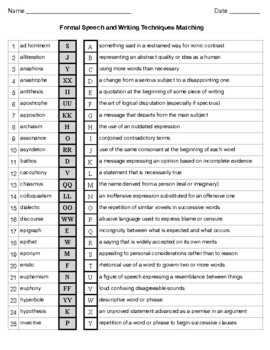
Formal Speech and Writing techniques Matching

Rhetorical Devices Word Search Puzzle

Formal Speech and Writing techniques Word Search

Syntactical Terms Practice | AP Lang & Pre-AP English

The Art of Persuasion powerpoint

Formal Speech and Writing techniques Crossword

Syntactical Terms Practice | AP Lang & Pre-AP English | Google Drive
- Google Drive™ folder

Rhetorical Appeals

Pres. Biden’s Inaugural Address : Rhetorical Devices Worksheet
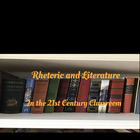
- Google Docs™
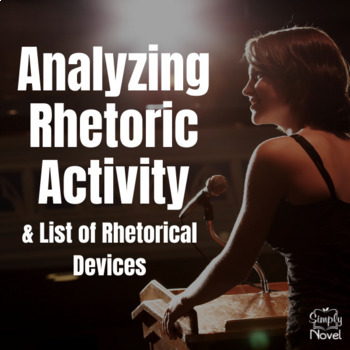
Rhetorical Devices List and Analyzing Rhetoric Activity - Use with ANY TEXT

- Google Apps™
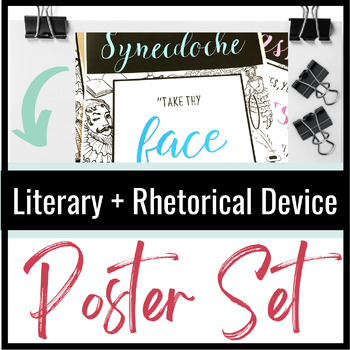
Literary & Rhetorical Device Poster Set for Secondary ELA -- Shakespeare Theme

I Have...Who Has? Vocabulary Game for SCHEMES AND TROPES

AP Language Device Bundle

Rhetorical Devices Practice: Why Gen Z is the Greatest Generation

Rhetoric of the American Revolution Full Texts and Analysis

Top Ten Language Techniques in Martin Luther King's Speeches and Writings

COMMON CORE CLOSE READ - JFK INAUGURAL ADDRESS WITH KEY 1360 LEXILE

- Word Document File

Quotes on New Year's Task cards bell ringers warm ups rhetoric analysis

Syntax: Sentence Mimicking Activity

Rhetorical Devices Through Cinema Print & Digital Bundle - Analysis Activities

AP Language Literary Devices and Analysis Reference Sheet
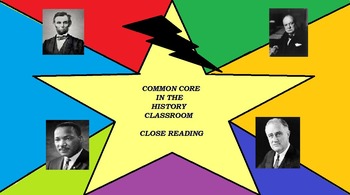
COMMON CORE CLOSE READ PRACTICE EXCERPTS - SKILL BUILDING
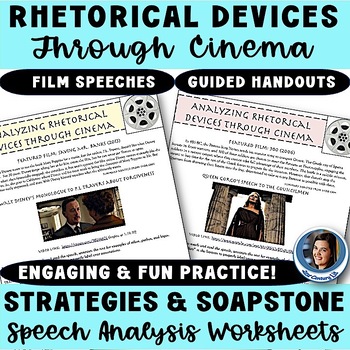
Analyzing Rhetorical Devices in Movie Speeches - Rhetoric Analysis Activities
- We're hiring
- Help & FAQ
- Privacy policy
- Student privacy
- Terms of service
- Tell us what you think
- Kindergarten
- Greater Than Less Than
- Measurement
- Multiplication
- Place Value
- Subtraction
- Punctuation
- 1st Grade Reading
- 2nd Grade Reading
- 3rd Grade Reading
- Cursive Writing
- Alphabet Coloring
- Animals Coloring
- Birthday Coloring
- Boys Coloring
- Buildings Coloring
- Cartoons Coloring
- Christmas Coloring
- Country Flag Coloring
- Country Map Coloring
- Disney Coloring
- Fantasy Coloring
- Food Coloring
- Girls Coloring
- Holidays Coloring
- Music Coloring
- Nature Coloring
- New Year Coloring
- People Coloring
- Religious Coloring
- Sports Coloring
- Toys Coloring
- Transportation Coloring
- US Sports Team Coloring
- Valentine Day Coloring
Displaying top 8 worksheets found for - Antithesis .
Some of the worksheets for this concept are Work 11a antithesis, Juxtaposition antithesis and oxymoron as taught by, Rhetorical devices practice, Rhetorical terms, Syntax and persuasion high school lesson about this lesson, Hamlet act questions answer, Dialectics acceptance change, Alliteration onomatopoeia metaphor simile hyperbole.
Found worksheet you are looking for? To download/print, click on pop-out icon or print icon to worksheet to print or download. Worksheet will open in a new window. You can & download or print using the browser document reader options.
1. Worksheet 11a Antithesis
2. juxtaposition, antithesis, and oxymoron as taught by ..., 3. rhetorical devices practice -, 4. rhetorical terms, 5. syntax and persuasion high school lesson about this lesson, 6. hamlet act questions answer sheet, 7. dialectics: acceptance & change, 8. alliteration onomatopoeia metaphor simile hyperbole ....

- Kindergarten
- Middle School
- High School
- Math Worksheets
- Language Arts
- Social Studies
Antithesis Examples
Antithesis is the term used to refer to an author's use of two contrasting or opposite terms in a sentence for effect. The two terms are set near each other to enhance or highlight the contrast in opposite meaning.
Sometimes, characters in literary works are the antithesis of each other. The two characters are shown as opposites in order to highlight the good qualities of one and the evil qualities of the other.
1. When he became the first man to walk on the moon, Neil Armstrong said that it was a " small step for man, but a giant leap for mankind."
2. "It was the best of times, it was the worst of times, it was the age of wisdom , it was the age of foolishness ." Charles Dickens, A Tale of Two Cities
3. Snow White and the Wicked Queen in Snow White and The Seven Dwarfsare the antithesis of each other.
4. "To err is human ; to forgive, divine ." Alexander Pope
5. The poem "Fire and Ice" by Robert Frost sets up a contrast between the terms "fire" and "ice".
6. "And let my liver rather heat with wine than my heart cool with mortifying groans. "The Merchant of Venice, Shakespeare
7. Let's agree to disagree .
More Topics
- Handwriting
- Difference Between
- 2020 Calendar
- Online Calculators
- Multiplication
Educational Videos
- Coloring Pages
- Privacy policy
- Terms of Use
© 2005-2020 Softschools.com
- Art & Design
- Design & Technology
- Physical Education
- Foreign Languages
- Greater Than Less Than
- Measurement
- Multiplication
- Place Value
- Subtraction
- Punctuation
- 1st Grade Reading
- 2nd Grade Reading
- 3rd Grade Reading
- Cursive Writing
Showing top 8 worksheets in the category - Antithesis .
Some of the worksheets displayed are Work 11a antithesis, Juxtaposition antithesis and oxymoron as taught by, Rhetorical devices practice, Rhetorical terms, Syntax and persuasion high school lesson about this lesson, Hamlet act questions answer, Dialectics acceptance change, Alliteration onomatopoeia metaphor simile hyperbole.
Once you find your worksheet, click on pop-out icon or print icon to worksheet to print or download. Worksheet will open in a new window. You can & download or print using the browser document reader options.
1. Worksheet 11a Antithesis
2. juxtaposition, antithesis, and oxymoron as taught by ..., 3. rhetorical devices practice -, 4. rhetorical terms, 5. syntax and persuasion high school lesson about this lesson, 6. hamlet act questions answer sheet, 7. dialectics: acceptance & change, 8. alliteration onomatopoeia metaphor simile hyperbole ....
- Kindergarten
- Greater Than Less Than
- Measurement
- Multiplication
- Place Value
- Subtraction
- Punctuation
- 1st Grade Reading
- 2nd Grade Reading
- 3rd Grade Reading
- Cursive Writing
- English & Literature (ELA)
- Social Studies
- Foreign Language

Displaying all worksheets related to - Antithesis .
Worksheets are Work 11a antithesis, Juxtaposition antithesis and oxymoron as taught by, Rhetorical devices practice, Rhetorical terms, Syntax and persuasion high school lesson about this lesson, Hamlet act questions answer, Dialectics acceptance change, Alliteration onomatopoeia metaphor simile hyperbole.
Click on pop-out icon or print icon to worksheet to print or download.
1. Worksheet 11a Antithesis
2. juxtaposition, antithesis, and oxymoron as taught by ..., 3. rhetorical devices practice -, 4. rhetorical terms, 5. syntax and persuasion high school lesson about this lesson, 6. hamlet act questions answer sheet, 7. dialectics: acceptance & change, 8. alliteration onomatopoeia metaphor simile hyperbole ....

- school Campus Bookshelves
- menu_book Bookshelves
- perm_media Learning Objects
- login Login
- how_to_reg Request Instructor Account
- hub Instructor Commons
- Download Page (PDF)
- Download Full Book (PDF)
- Periodic Table
- Physics Constants
- Scientific Calculator
- Reference & Cite
- Tools expand_more
- Readability
selected template will load here
This action is not available.

9: The Antithesis Exercise
- Last updated
- Save as PDF
- Page ID 6523

- Steven D. Krause
- Eastern Michigan University
If you are coming to this chapter after working through some of the earlier exercises in this part of the book, you might find yourself quite attached to your topic and your working thesis. Perhaps you are so attached and focused on your topic that you have a hard time imagining why anyone would disagree with you. This attachment is certainly understandable. After you have done so much hunting in the library and on the Internet and thinking about your working thesis, you might have a hard time imaging how anyone could possibly disagree with your position, or why they would want to. But it is important to remember that not all of your potential readers are going to automatically agree with you. If your topic or take on an issue is particularly controversial, you might have to work hard at convincing almost all of your readers about the validity of your argument.
The process of considering opposing viewpoints is the goal of this exercise, the Antithesis essay. Think about this exercise as a way of exploring the variety of different and opposing views to the main argument you are trying to make with your research project.
- 9.1: Revisiting the Working (and Inevitably Changing) Thesis
- 9.2: Why Write an Antithesis Essay?
- 9.3: Generating Antithetical Points in Five Easy Steps
- 9.4: Finding Antithetical Points on the Internet
- 9.5: Strategies for Answering Antithetical Arguments
- 9.6: Assignment- Writing the Antithesis Essay
- 9.7: A Student Example- “Are Casinos Good For Las Vegas? Defending Legalized Gambling,” by Kerry Oaks
- English Grammar
- Figures Of Speech
Antithesis: Meaning, Definition and Examples
Figures of speech , otherwise known as rhetorical devices, are used in the English language to beautify and make your language look and sound a lot more effective rather than a literal presentation of information. Each figure of speech has its function and is meant to perform its roles giving the context a unique effect. In this article, you will learn about one such figure of speech called antithesis. Read through the article to learn more about what antithesis is, its definition and how it differs from an oxymoron. You can also check out the examples and analyse how it is written for an in-depth understanding of the same.
Table of Contents
What is antithesis – meaning and definition, what differentiates an antithesis from an oxymoron, some common examples of antithesis, frequently asked questions on antithesis.
An antithesis is a figure of speech that states strongly contrasting ideas placed in juxtaposition. They contain compound sentences with the two independent clauses separated by a comma or a semicolon , in most cases. However, there are also instances where the antithesis is a compound sentence with a conjunction . An antithesis is mainly used to portray the stark difference between the two opposing ideas.
Antithesis, according to the Oxford Learner’s Dictionary, is defined as “a contrast between two things”, and according to the Cambridge Dictionary, “a difference or opposition between two things”. The Merriam-Webster Dictionary gives a more explanatory definition. According to it, antithesis is “the rhetorical contrast of ideas by means of parallel arrangements of words, clauses, or sentences”.
Knowing the difference between an antithesis and an oxymoron will help you comprehend and use both the rhetorical devices effectively. Take a look at the table given below to learn more.
Here are some of the most common examples of antithesis for your reference.
- Hope for the best; prepare for the worst.
- Keep your mouth closed and your eyes open.
- “It was the best of times, it was the worst of times. It was the age of wisdom, it was the age of foolishness.” – Charles Dickens
- “That’s one small step for a man, one giant leap for mankind.” – Neil Armstrong
- “Better to reign in Hell, than to serve in Heaven.” – John Milton
- Speech is silver, but silence is gold.
- “Give every man thy ear, but few thy voice.” – William Shakespeare
- Keep your friends close; keep your enemies closer.
- “To err is human; to forgive divine.” – Alexander Pope
- Money is the root of all evil: poverty is the fruit of all goodness.
What is antithesis?
An antithesis is a figure of speech that states strongly contrasting ideas placed in juxtaposition. They contain compound sentences with the two independent clauses separated by a comma or a semicolon, in most cases. However, there are also instances where the antithesis is a compound sentence with a conjunction.
What is the definition of antithesis?
What is the difference between antithesis and oxymoron.
The main difference between an antithesis and an oxymoron is that antithesis refers to the use of two contrasting ideas or thoughts conveyed in two independent clauses placed in juxtaposition, separated by a comma, a semicolon or a conjunction; whereas, the term ‘oxymoron’ refers to the use of two opposite words within a phrase to create an effect.
Give some examples of antithesis.
Here are a few examples of antithesis for your reference.
- “Love is an ideal thing, marriage a real thing.” – Goethe
- “Folks who have no vices have very few virtues.” – Abraham Lincoln
- “Man proposes, God disposes.”
- Beggars can’t be choosers.
- Be slow in choosing, but slower in changing.
Leave a Comment Cancel reply
Your Mobile number and Email id will not be published. Required fields are marked *
Request OTP on Voice Call
Post My Comment
- Share Share
Register with BYJU'S & Download Free PDFs
Register with byju's & watch live videos.
- Kindergarten
- Greater Than Less Than
- Measurement
- Multiplication
- Place Value
- Subtraction
- Punctuation
- 1st Grade Reading
- 2nd Grade Reading
- 3rd Grade Reading
- Cursive Writing
Antithesis - Displaying top 8 worksheets found for this concept.
Some of the worksheets for this concept are Work 11a antithesis, Juxtaposition antithesis and oxymoron as taught by, Rhetorical devices practice, Rhetorical terms, Syntax and persuasion high school lesson about this lesson, Hamlet act questions answer, Dialectics acceptance change, Alliteration onomatopoeia metaphor simile hyperbole.
Found worksheet you are looking for? To download/print, click on pop-out icon or print icon to worksheet to print or download. Worksheet will open in a new window. You can & download or print using the browser document reader options.
1. Worksheet 11a Antithesis
2. juxtaposition, antithesis, and oxymoron as taught by ..., 3. rhetorical devices practice -, 4. rhetorical terms, 5. syntax and persuasion high school lesson about this lesson, 6. hamlet act questions answer sheet, 7. dialectics: acceptance & change, 8. alliteration onomatopoeia metaphor simile hyperbole ....

IMAGES
VIDEO
COMMENTS
All About These 15 Worksheets. Antithesis, the rhetorical device that juxtaposes contrasting ideas or words within a sentence to create a balanced and thought-provoking effect, is a powerful tool in writing and communication. Understanding and mastering antithesis not only enhances a student's grasp of persuasive techniques but also sharpens ...
Antithesis is a literary device designed to highlight the difference/s of two irreconcilable opposites. Download our 5 ready-to-use antithesis worksheets that are perfect to test student knowledge and understanding of what antithesis is and how it can be used.
Antithesis is a figure of speech that juxtaposes two contrasting or opposing ideas, usually within parallel grammatical structures. For instance, Neil Armstrong used antithesis when he stepped onto the surface of the moon in 1969 and said, "That's one small step for a man, one giant leap for mankind." This is an example of antithesis because ...
An antithesis is just that—an "anti" "thesis.". An antithesis is used in writing to express ideas that seem contradictory. An antithesis uses parallel structure of two ideas to communicate this contradiction. Example of Antithesis: "Float like a butterfly, sting like a bee." -Muhammad Ali. This example of antithesis is a famous ...
Print Worksheet. 1. For what reason would an author employ antithesis? to highlight contrasting ideas. to confound the reader. to distract from events in the background. to inspire fan loyalty. 2 ...
Browse antithesis worksheet resources on Teachers Pay Teachers, a marketplace trusted by millions of teachers for original educational resources.
Finally! No cutesy graphics or childish activities here! The activities and PPT included here can be used as an introduction or review for antithesis and juxtaposition for your high school and middle school students. Your students will be engaged and have fun in this set of lessons that is not your typical "worksheet" plan. I believe humour and joy can bring a lot to a lesson and is often a ...
Since antithesis is intended to be a figure of speech, such statements are not meant to be understood in a literal manner. Here are some examples of antithesis used in everyday speech: Go big or go home. Spicy food is heaven on the tongue but hell in the tummy. Those who can, do; those who can't do, teach. Get busy living or get busy dying.
Plants never grow at the same rate, and that is the antithesis for this word problem involving multiplication of fractions. On the worksheet, Raul notices that Pablo's seedlings are 1 1/2 times as tall, and Celina's seedlings are 3/4 as...
Peer marking - What went well and Even better if. Lesson 2. Re-consideration of starter from lesson 1. Students write a speech on the topic of their choice using persuasive devices and the antithesis they created from the previous lesson. Folder includes 21 slide powerpoint; extract of speech and worksheet writing frame to create antithesis.
Slices of American Pie: The 1960s Through Music. Eleventh graders examine political, cultural, and social movements through music. In this 1960s American history lesson, 11th graders explore the music of the decade in order to better understand the complexity of the time period.... Find antithesis and examples lesson plans and teaching resources.
5.0. (3) $4.00. PPTX. Twelve slide powerpoint defining different types of rhetoric (ethos, pathos, logos) and then defining several different types of rhetorical devices including anaphora, antithesis, rhetorical questions, and parallelism. The presentation also includes examples of each type of device. The last slide applies specifically to ...
Antithesis. Displaying top 8 worksheets found for - Antithesis. Some of the worksheets for this concept are Work 11a antithesis, Juxtaposition antithesis and oxymoron as taught by, Rhetorical devices practice, Rhetorical terms, Syntax and persuasion high school lesson about this lesson, Hamlet act questions answer, Dialectics acceptance change ...
Antithesis is the term used to refer to an author's use of two contrasting or opposite terms in a sentence for effect. The two terms are set near each other to enhance or highlight the contrast in opposite meaning. Sometimes, characters in literary works are the antithesis of each other. The two characters are shown as opposites in order to highlight the good qualities of one and the evil ...
Showing top 8 worksheets in the category - Antithesis. Some of the worksheets displayed are Work 11a antithesis, Juxtaposition antithesis and oxymoron as taught by, Rhetorical devices practice, Rhetorical terms, Syntax and persuasion high school lesson about this lesson, Hamlet act questions answer, Dialectics acceptance change, Alliteration onomatopoeia metaphor simile hyperbole.
Displaying all worksheets related to - Antithesis. Worksheets are Work 11a antithesis, Juxtaposition antithesis and oxymoron as taught by, Rhetorical devices practice, Rhetorical terms, Syntax and persuasion high school lesson about this lesson, Hamlet act questions answer, Dialectics acceptance change, Alliteration onomatopoeia metaphor simile hyperbole.
The process of considering opposing viewpoints is the goal of this exercise, the Antithesis essay. Think about this exercise as a way of exploring the variety of different and opposing views to the main argument you are trying to make with your research project. 9.1: Revisiting the Working (and Inevitably Changing) Thesis ...
The American Saga. Listening activity with some speaking. Ss listen to an analiysis of Obama's 2004 Convention Speech and mark some statements true or false. They then watc... 136 uses. A selection of English ESL antithesis printables.
Antithesis is a figure of speech that places two completely contrasting ideas or clauses in juxtaposition. An oxymoron is a figure of speech that contains two opposing or contrasting words placed adjacent to each other within a phrase to produce an effect. For example: "Art is long, and Time is fleeting.". For example:
Antithesis-Worksheets - Free download as PDF File (.pdf), Text File (.txt) or read online for free.
Smart Learning
Displaying all worksheets related to - Antithesis. Worksheets are Work 11a antithesis, Juxtaposition antithesis and oxymoron as taught by, Rhetorical devices practice, Rhetorical terms, Syntax and persuasion high school lesson about this lesson, Hamlet act questions answer, Dialectics acceptance change, Alliteration onomatopoeia metaphor simile hyperbole.
Antithesis - Displaying top 8 worksheets found for this concept. Some of the worksheets for this concept are Work 11a antithesis, Juxtaposition antithesis and oxymoron as taught by, Rhetorical devices practice, Rhetorical terms, Syntax and persuasion high school lesson about this lesson, Hamlet act questions answer, Dialectics acceptance change ...